turn signal BMW M3 COUPE 2001 E46 Owner's Manual
[x] Cancel search | Manufacturer: BMW, Model Year: 2001, Model line: M3 COUPE, Model: BMW M3 COUPE 2001 E46Pages: 183, PDF Size: 1.65 MB
Page 10 of 183
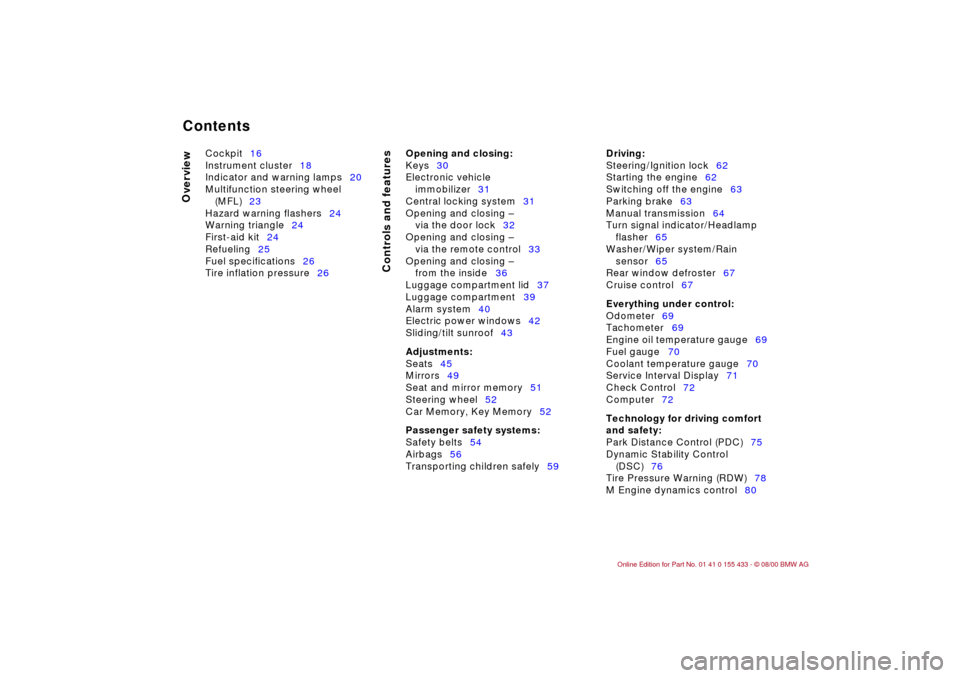
Contents
Overview
Controls and features
Cockpit16
Instrument cluster18
Indicator and warning lamps20
Multifunction steering wheel
(MFL)23
Hazard warning flashers24
Warning triangle24
First-aid kit24
Refueling25
Fuel specifications26
Tire inflation pressure26
Opening and closing:
Keys30
Electronic vehicle
immobilizer31
Central locking system31
Opening and closing Ð
via the door lock32
Opening and closing Ð
via the remote control33
Opening and closing Ð
from the inside36
Luggage compartment lid37
Luggage compartment39
Alarm system40
Electric power windows42
Sliding/tilt sunroof43
Adjustments:
Seats45
Mirrors49
Seat and mirror memory51
Steering wheel52
Car Memory, Key Memory52
Passenger safety systems:
Safety belts54
Airbags56
Transporting children safely59
Driving:
Steering/Ignition lock62
Starting the engine62
Switching off the engine63
Parking brake63
Manual transmission64
Turn signal indicator/Headlamp
flasher65
Washer/Wiper system/Rain
sensor65
Rear window defroster67
Cruise control67
Everything under control:
Odometer69
Tachometer69
Engine oil temperature gauge69
Fuel gauge70
Coolant temperature gauge70
Service Interval Display71
Check Control72
Computer72
Technology for driving comfort
and safety:
Park Distance Control (PDC)75
Dynamic Stability Control
(DSC)76
Tire Pressure Warning (RDW)78
M Engine dynamics control80
Contents
Page 17 of 183
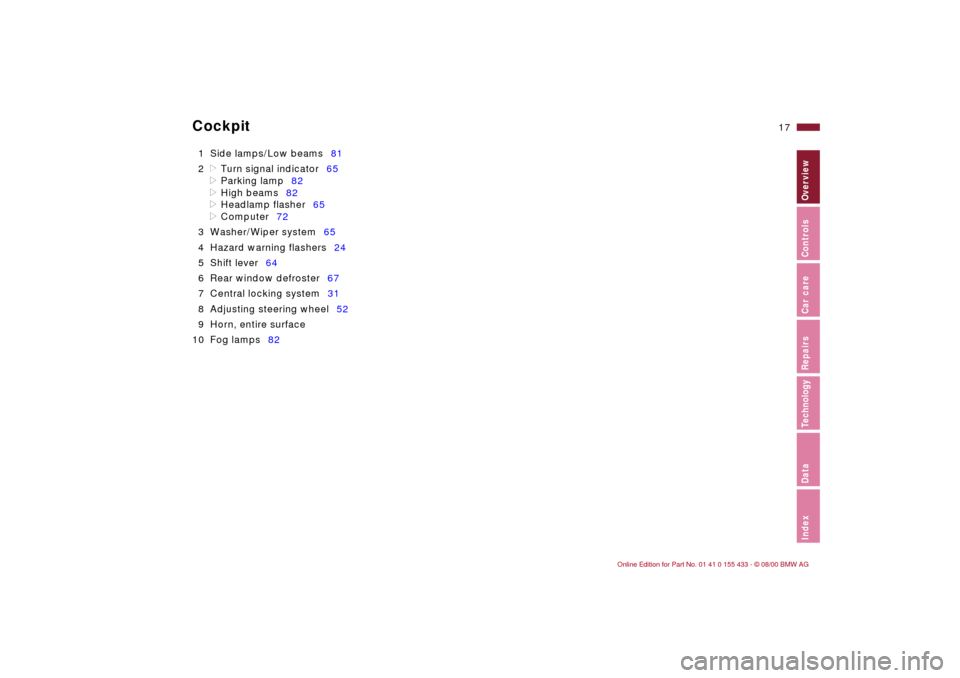
17n
IndexDataTechnologyRepairsCar careControlsOverview
Cockpit
1 Side lamps/Low beams81
2
d
Turn signal indicator65
>
Parking lamp82
>
High beams82
>
Headlamp flasher65
>
Computer72
3 Washer/Wiper system65
4 Hazard warning flashers24
5 Shift lever64
6 Rear window defroster67
7 Central locking system31
8 Adjusting steering wheel52
9 Horn, entire surface
10 Fog lamps82
Page 19 of 183
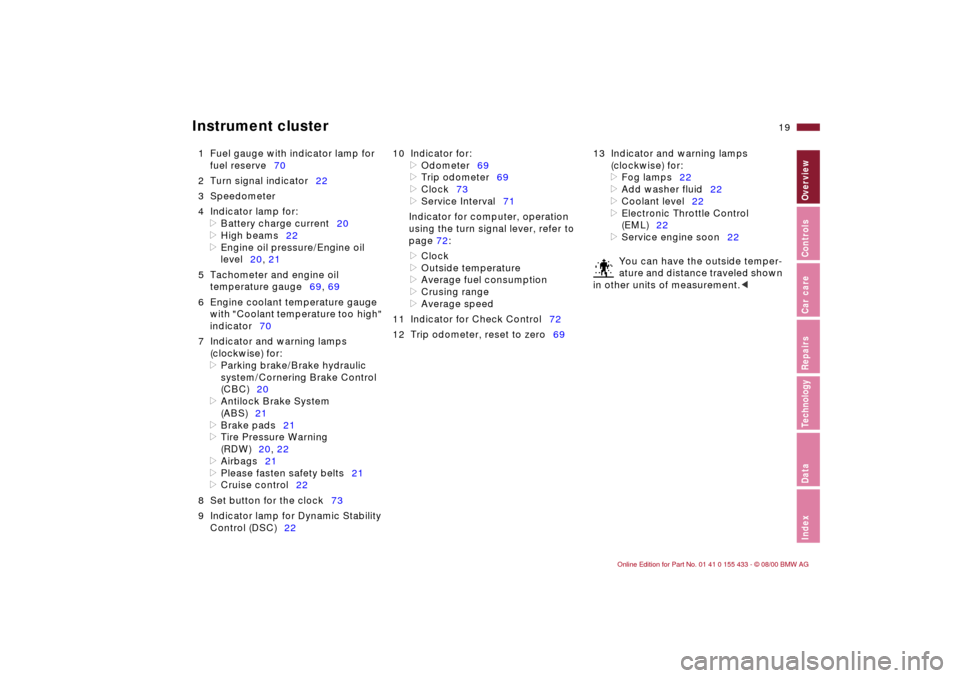
19n
IndexDataTechnologyRepairsCar careControlsOverview
Instrument cluster
1 Fuel gauge with indicator lamp for
fuel reserve70
2 Turn signal indicator22
3 Speedometer
4 Indicator lamp for:
>
Battery charge current20
>
High beams22
>
Engine oil pressure/Engine oil
level20, 21
5 Tachometer and engine oil
temperature gauge69, 69
6 Engine coolant temperature gauge
with "Coolant temperature too high"
indicator70
7 Indicator and warning lamps
(clockwise) for:
>
Parking brake/Brake hydraulic
system/Cornering Brake Control
(CBC)20
>
Antilock Brake System
(ABS)21
>
Brake pads21
>
Tire Pressure Warning
(RDW)20, 22
>
Airbags21
>
Please fasten safety belts21
>
Cruise control22
8 Set button for the clock73
9 Indicator lamp for Dynamic Stability
Control (DSC)2210 Indicator for:
>
Odometer69
>
Trip odometer69
>
Clock73
>
Service Interval71
Indicator for computer, operation
using the turn signal lever, refer to
page 72:
>
Clock
>
Outside temperature
>
Average fuel consumption
>
Crusing range
>
Average speed
11 Indicator for Check Control72
12 Trip odometer, reset to zero6913 Indicator and warning lamps
(clockwise) for:
>
Fog lamps22
>
Add washer fluid22
>
Coolant level22
>
Electronic Throttle Control
(EML)22
>
Service engine soon22
You can have the outside temper-
ature and distance traveled shown
in other units of measurement.
<
Page 20 of 183
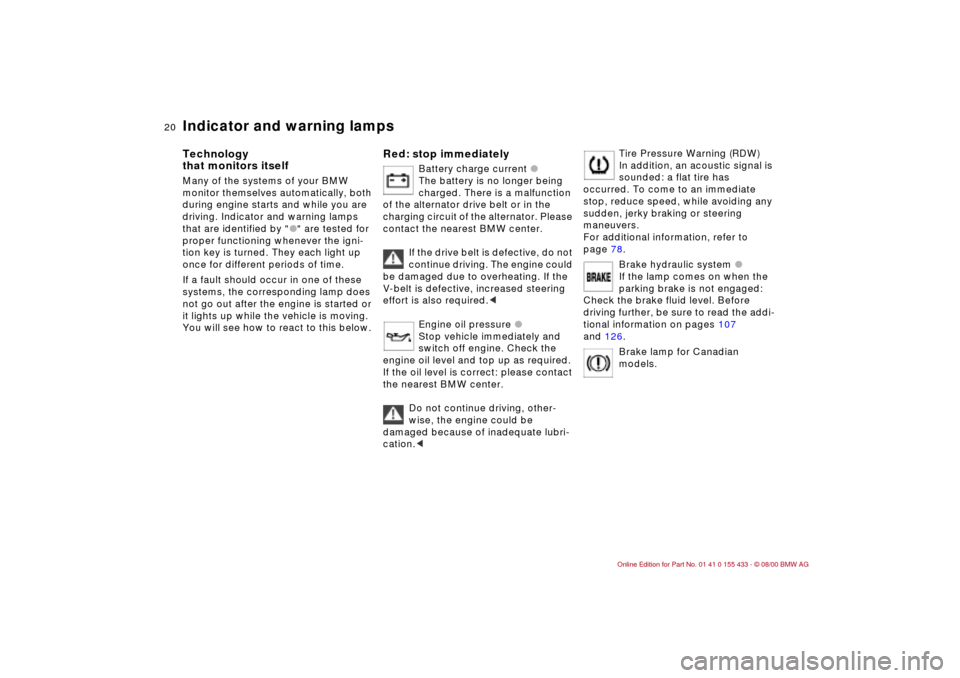
20n
Indicator and warning lamps
Technology
that monitors itself
Many of the systems of your BMW
monitor themselves automatically, both
during engine starts and while you are
driving. Indicator and warning lamps
that are identified by "
l
" are tested for
proper functioning whenever the igni-
tion key is turned. They each light up
once for different periods of time.
If a fault should occur in one of these
systems, the corresponding lamp does
not go out after the engine is started or
it lights up while the vehicle is moving.
You will see how to react to this below.
Red: stop immediately
Battery charge current
l
The battery is no longer being
charged. There is a malfunction
of the alternator drive belt or in the
charging circuit of the alternator. Please
contact the nearest BMW center.
If the drive belt is defective, do not
continue driving. The engine could
be damaged due to overheating. If the
V-belt is defective, increased steering
effort is also required.
<
Engine oil pressure
l
Stop vehicle immediately and
switch off engine. Check the
engine oil level and top up as required.
If the oil level is correct: please contact
the nearest BMW center.
Do not continue driving, other-
wise, the engine could be
damaged because of inadequate lubri-
cation.
<
Tire Pressure Warning (RDW)
In addition, an acoustic signal is
sounded: a flat tire has
occurred. To come to an immediate
stop, reduce speed, while avoiding any
sudden, jerky braking or steering
maneuvers.
For additional information, refer to
page 78.
Brake hydraulic system
l
If the lamp comes on when the
parking brake is not engaged:
Check the brake fluid level. Before
driving further, be sure to read the addi-
tional information on pages 107
and 126.
Brake lamp for Canadian
models.
Page 22 of 183
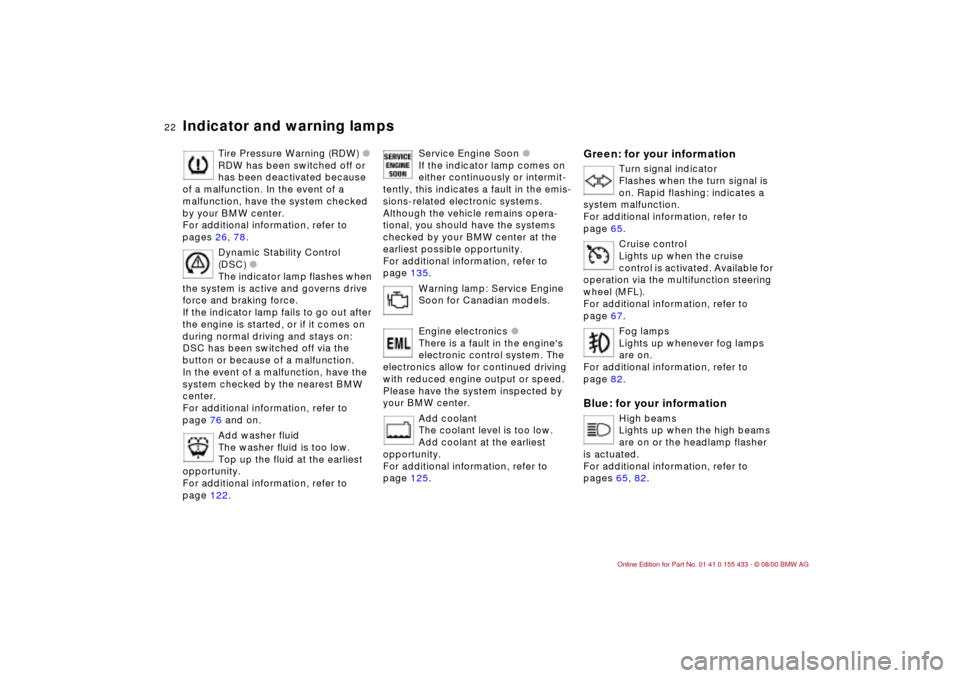
22n
Indicator and warning lamps
Tire Pressure Warning (RDW) l
RDW has been switched off or
has been deactivated because
of a malfunction. In the event of a
malfunction, have the system checked
by your BMW center.
For additional information, refer to
pages 26, 78.
Dynamic Stability Control
(DSC) l
The indicator lamp flashes when
the system is active and governs drive
force and braking force.
If the indicator lamp fails to go out after
the engine is started, or if it comes on
during normal driving and stays on:
DSC has been switched off via the
button or because of a malfunction.
In the event of a malfunction, have the
system checked by the nearest BMW
center.
For additional information, refer to
page 76 and on.
Add washer fluid
The washer fluid is too low.
Top up the fluid at the earliest
opportunity.
For additional information, refer to
page 122.
Service Engine Soon l
If the indicator lamp comes on
either continuously or intermit-
tently, this indicates a fault in the emis-
sions-related electronic systems.
Although the vehicle remains opera-
tional, you should have the systems
checked by your BMW center at the
earliest possible opportunity.
For additional information, refer to
page 135.
Warning lamp: Service Engine
Soon for Canadian models.
Engine electronics l
There is a fault in the engine's
electronic control system. The
electronics allow for continued driving
with reduced engine output or speed.
Please have the system inspected by
your BMW center.
Add coolant
The coolant level is too low.
Add coolant at the earliest
opportunity.
For additional information, refer to
page 125.
Green: for your information
Turn signal indicator
Flashes when the turn signal is
on. Rapid flashing: indicates a
system malfunction.
For additional information, refer to
page 65.
Cruise control
Lights up when the cruise
control is activated. Available for
operation via the multifunction steering
wheel (MFL).
For additional information, refer to
page 67.
Fog lamps
Lights up whenever fog lamps
are on.
For additional information, refer to
page 82.
Blue: for your information
High beams
Lights up when the high beams
are on or the headlamp flasher
is actuated.
For additional information, refer to
pages 65, 82.
Page 24 of 183
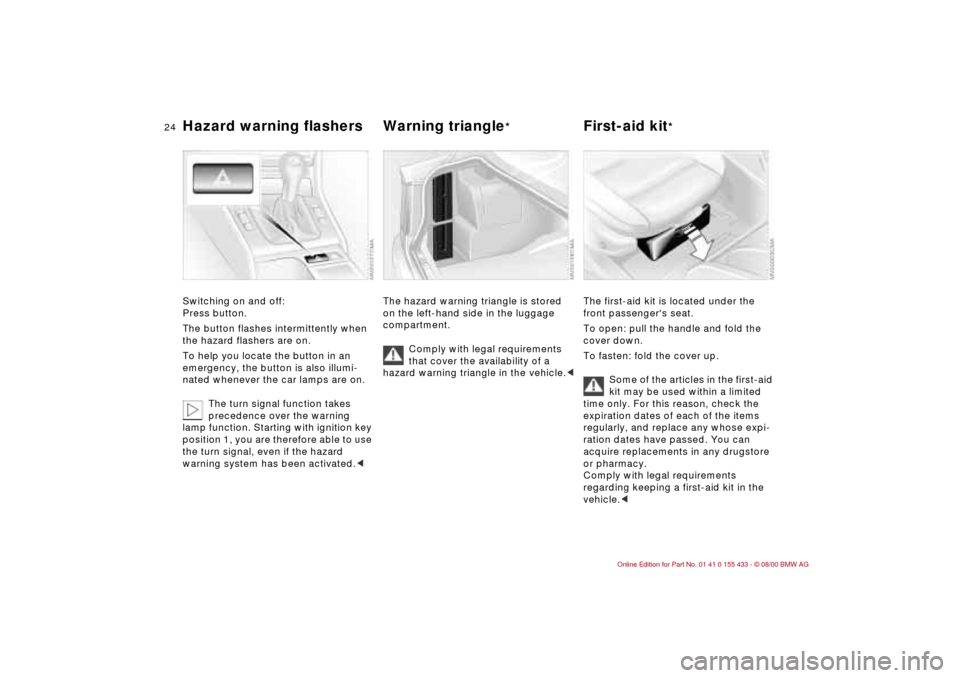
24n
Hazard warning flashers Warning triangle
*
First-aid kit
*
Switching on and off:
Press button.
The button flashes intermittently when
the hazard flashers are on.
To help you locate the button in an
emergency, the button is also illumi-
nated whenever the car lamps are on.
The turn signal function takes
precedence over the warning
lamp function. Starting with ignition key
position 1, you are therefore able to use
the turn signal, even if the hazard
warning system has been activated.<
The hazard warning triangle is stored
on the left-hand side in the luggage
compartment.
Comply with legal requirements
that cover the availability of a
hazard warning triangle in the vehicle.<
The first-aid kit is located under the
front passenger's seat.
To open: pull the handle and fold the
cover down.
To fasten: fold the cover up.
Some of the articles in the first-aid
kit may be used within a limited
time only. For this reason, check the
expiration dates of each of the items
regularly, and replace any whose expi-
ration dates have passed. You can
acquire replacements in any drugstore
or pharmacy.
Comply with legal requirements
regarding keeping a first-aid kit in the
vehicle.<
Page 29 of 183
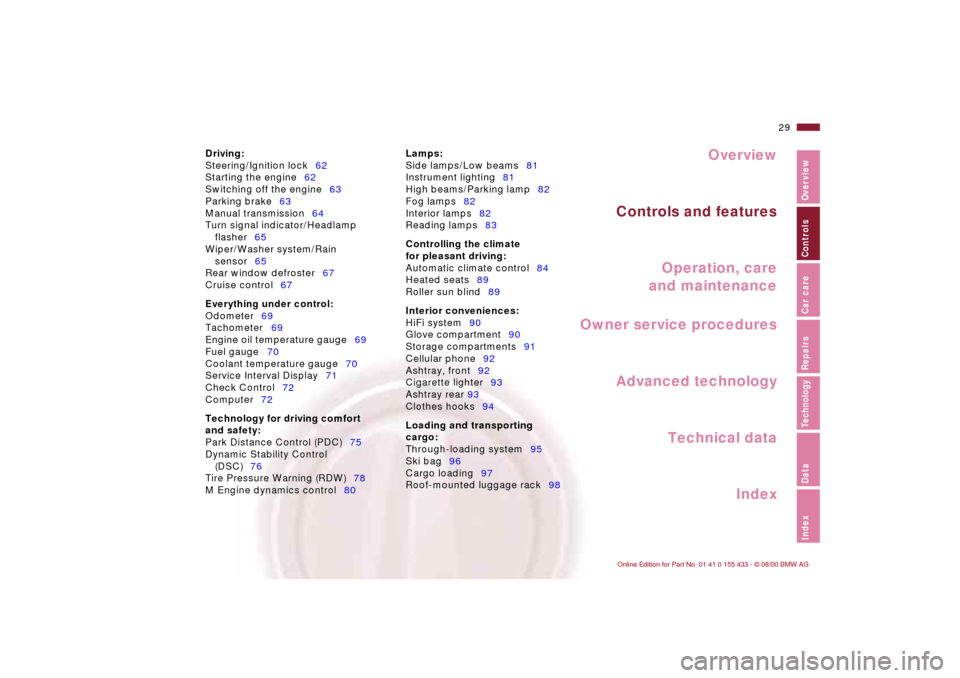
Overview
Controls and features
Operation, care
and maintenance
Owner service procedures
Technical data
Index Advanced technology
29n
IndexDataTechnologyRepairsCar careControlsOverview
Driving:
Steering/Ignition lock62
Starting the engine62
Switching off the engine63
Parking brake63
Manual transmission64
Turn signal indicator/Headlamp
flasher65
Wiper/Washer system/Rain
sensor65
Rear window defroster67
Cruise control67
Everything under control:
Odometer69
Tachometer69
Engine oil temperature gauge69
Fuel gauge70
Coolant temperature gauge70
Service Interval Display71
Check Control72
Computer72
Technology for driving comfort
and safety:
Park Distance Control (PDC)75
Dynamic Stability Control
(DSC)76
Tire Pressure Warning (RDW)78
M Engine dynamics control80Lamps:
Side lamps/Low beams81
Instrument lighting81
High beams/Parking lamp82
Fog lamps82
Interior lamps82
Reading lamps83
Controlling the climate
for pleasant driving:
Automatic climate control84
Heated seats89
Roller sun blind89
Interior conveniences:
HiFi system90
Glove compartment90
Storage compartments91
Cellular phone92
Ashtray, front92
Cigarette lighter93
Ashtray rear 93
Clothes hooks94
Loading and transporting
cargo:
Through-loading system95
Ski bag96
Cargo loading97
Roof-mounted luggage rack98
Page 32 of 183
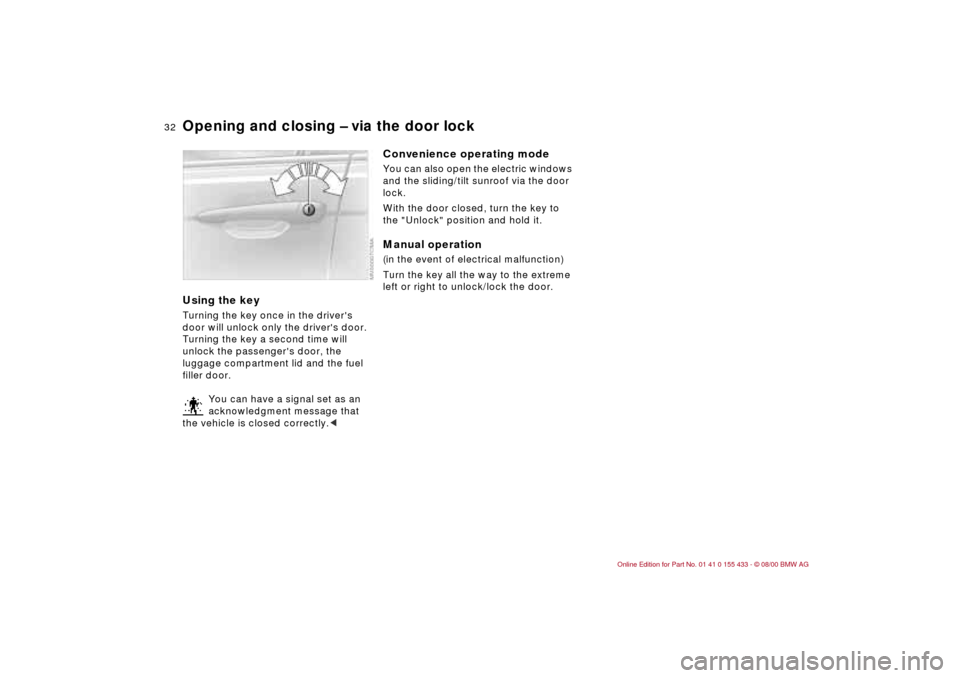
32n
Opening and closing Ð via the door lockUsing the keyTurning the key once in the driver's
door will unlock only the driver's door.
Turning the key a second time will
unlock the passenger's door, the
luggage compartment lid and the fuel
filler door.
You can have a signal set as an
acknowledgment message that
the vehicle is closed correctly.<
Convenience operating modeYou can also open the electric windows
and the sliding/tilt sunroof via the door
lock.
With the door closed, turn the key to
the "Unlock" position and hold it.Manual operation (in the event of electrical malfunction)
Turn the key all the way to the extreme
left or right to unlock/lock the door.
Page 62 of 183
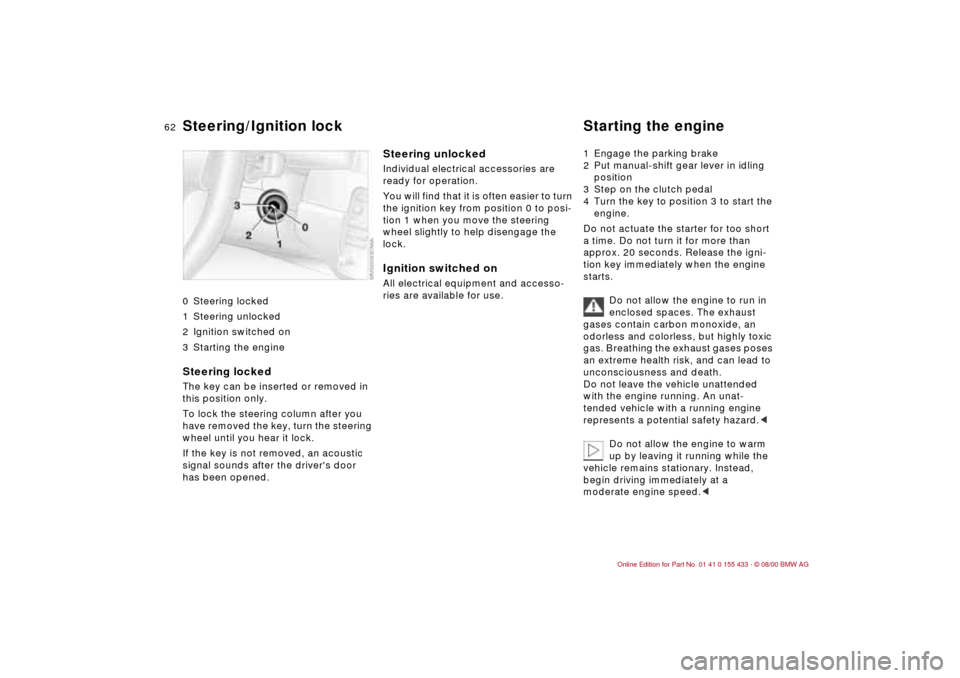
62n
0 Steering locked
1 Steering unlocked
2 Ignition switched on
3 Starting the engine
Steering locked The key can be inserted or removed in
this position only.
To lock the steering column after you
have removed the key, turn the steering
wheel until you hear it lock.
If the key is not removed, an acoustic
signal sounds after the driver's door
has been opened.
Steering unlocked Individual electrical accessories are
ready for operation.
You will find that it is often easier to turn
the ignition key from position 0 to posi-
tion 1 when you move the steering
wheel slightly to help disengage the
lock. Ignition switched onAll electrical equipment and accesso-
ries are available for use. 1 Engage the parking brake
2 Put manual-shift gear lever in idling
position
3 Step on the clutch pedal
4 Turn the key to position 3 to start the
engine.
Do not actuate the starter for too short
a time. Do not turn it for more than
approx. 20 seconds. Release the igni-
tion key immediately when the engine
starts.
Do not allow the engine to run in
enclosed spaces. The exhaust
gases contain carbon monoxide, an
odorless and colorless, but highly toxic
gas. Breathing the exhaust gases poses
an extreme health risk, and can lead to
unconsciousness and death.
Do not leave the vehicle unattended
with the engine running. An unat-
tended vehicle with a running engine
represents a potential safety hazard.<
Do not allow the engine to warm
up by leaving it running while the
vehicle remains stationary. Instead,
begin driving immediately at a
moderate engine speed.<
Steering/Ignition lock Starting the engine
Page 64 of 183
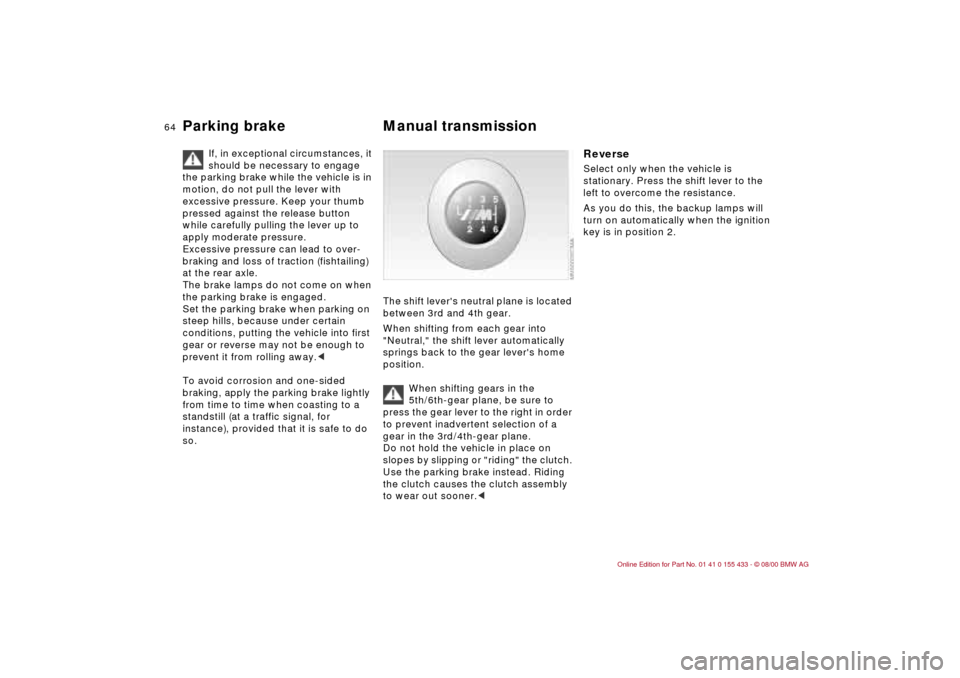
64n
Parking brake Manual transmission
If, in exceptional circumstances, it
should be necessary to engage
the parking brake while the vehicle is in
motion, do not pull the lever with
excessive pressure. Keep your thumb
pressed against the release button
while carefully pulling the lever up to
apply moderate pressure.
Excessive pressure can lead to over-
braking and loss of traction (fishtailing)
at the rear axle.
The brake lamps do not come on when
the parking brake is engaged.
Set the parking brake when parking on
steep hills, because under certain
conditions, putting the vehicle into first
gear or reverse may not be enough to
prevent it from rolling away.<
To avoid corrosion and one-sided
braking, apply the parking brake lightly
from time to time when coasting to a
standstill (at a traffic signal, for
instance), provided that it is safe to do
so.
The shift lever's neutral plane is located
between 3rd and 4th gear.
When shifting from each gear into
"Neutral," the shift lever automatically
springs back to the gear lever's home
position.
When shifting gears in the
5th/6th-gear plane, be sure to
press the gear lever to the right in order
to prevent inadvertent selection of a
gear in the 3rd/4th-gear plane.
Do not hold the vehicle in place on
slopes by slipping or "riding" the clutch.
Use the parking brake instead. Riding
the clutch causes the clutch assembly
to wear out sooner.<
Reverse Select only when the vehicle is
stationary. Press the shift lever to the
left to overcome the resistance.
As you do this, the backup lamps will
turn on automatically when the ignition
key is in position 2.